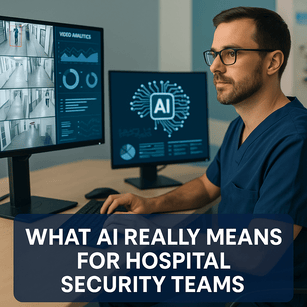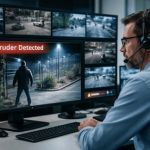
Artificial Intelligence (AI) is often treated like a buzzword. It’s touted as transformative, disruptive, and futuristic—but what does it actually mean for hospital security teams working in real time, with real people, in high-stakes environments?
In healthcare, the stakes are higher than in many industries. Security must protect patients, staff, medications, data, and physical infrastructure—often with limited personnel and across sprawling facilities. For hospital security teams, AI isn’t about replacing people—it’s about enhancing their capabilities.
This article breaks down how AI is already being used in hospital security systems, what’s hype vs. reality, and how to implement it meaningfully without sacrificing compliance, workflow, or human judgment.
k
k
The Challenges AI Helps Solve in Hospital Security
Healthcare security teams face unique and growing pressures:
-
Increased workplace violence and aggression in emergency departments
-
Staff shortages, leading to fewer eyes on surveillance feeds
-
High visitor volume and rotating temp workers
-
Compliance demands (HIPAA, Joint Commission, OSHA)
-
Vast facility footprints with dozens of access points and risk zones
AI-enabled tools are designed to support security officers and administrators—not replace them—by automating tasks, surfacing risks, and making systems more responsive.
j
k
How AI Is Being Used in Hospital Security Today
1. AI-Powered Video Analytics
This is one of the most mature and widely adopted uses of AI in hospital security. Video management systems (VMS) enhanced with AI can:
-
Detect unusual behaviors like loitering, rapid movement, or physical altercations
-
Alert staff to unauthorized access attempts or door propping
-
Automatically focus cameras on movement patterns (e.g., someone approaching a restricted area)
This turns passive surveillance into proactive monitoring, even in low-staffed security operations.
Example: An AI-enabled camera near the ER recognizes repeated pacing and agitation in a visitor. It flags the footage for review, helping staff intervene before the situation escalates.
k
k
2. Facial Recognition and Object Detection (Used Ethically)
In areas like pharmacy storage, NICUs, or data centers, some hospitals use AI-driven facial recognition (where legal) to ensure that only authorized, pre-verified individuals gain access.
AI can also detect objects such as:
-
Bags left unattended
-
Entry of unauthorized equipment
-
Presence of unauthorized individuals in staff-only zones
All of this reduces reliance on manual footage review and provides better situational awareness.
k
k
3. Smart Access Control and Behavior-Based Alerts
Modern access control systems are beginning to use AI to detect unusual badge behavior:
-
Badges used at odd times or in unusual sequences
-
Attempts to “tailgate” through a secure door
-
Simultaneous badge activity in two locations (badge cloning)
AI flags these anomalies and prompts investigation—before a breach happens.
k
k
4. Predictive Maintenance for Security Equipment
AI isn’t just for threat detection—it can also improve system health. Integrated platforms now use machine learning to:
-
Predict when cameras are likely to fail based on performance patterns
-
Notify staff of badge reader malfunctions or network lags
-
Schedule proactive maintenance alerts for surveillance or access control systems
This reduces downtime, saves costs, and ensures compliance by keeping critical systems online.
k
k
5. Workflow Automation and Reporting
AI can simplify the administrative burden of security:
-
Automatically generate daily or weekly activity summaries
-
Highlight events tied to specific departments or access zones
-
Create dashboards for compliance audits or board-level review
This makes security data more actionable—without creating more work.
k
k
What AI Is Not in Hospital Security
To be clear, AI is not:
-
A replacement for trained security personnel
-
A surveillance free-for-all (HIPAA still applies)
-
A fix-all solution for systemic security weaknesses
-
Fully autonomous—most systems still require human oversight and approval
AI is a force multiplier, not a substitute. It amplifies your team's ability to detect, decide, and respond faster.
k
k
AI & Compliance: What to Watch For
Before deploying any AI-enhanced system, hospital security leaders must ensure:
-
HIPAA compliance for any surveillance or data analysis
-
Role-based access controls for AI-generated insights
-
Data storage policies aligned with hospital IT and legal teams
-
Clear policies on what AI monitors and who reviews alerts
In some states or jurisdictions, facial recognition must be opt-in or banned altogether—know the local laws and work closely with compliance officers.
k
k
Implementing AI Without Overhauling Everything
You don’t need to start from scratch to benefit from AI. Start with:
✅ AI plug-ins or modules for existing surveillance systems
✅ Vendors who offer open architecture and easy integrations
✅ Small pilot programs in high-risk areas (e.g., ED, maternity, pharmacy)
✅ Staff training that emphasizes augmentation—not replacement
This approach allows for gradual adoption, measurable results, and staff buy-in.
k
k
Conclusion: Smarter Security That Works with You
For hospital security teams, AI offers a powerful opportunity to improve visibility, responsiveness, and efficiency. But it must be implemented thoughtfully—with respect for privacy, a focus on practical use cases, and clear human oversight.
When done right, AI doesn’t complicate your system. It simplifies what matters, so your people can focus on protecting what matters most.
Talk to SSP about how AI-powered tools can elevate your hospital’s security—without overwhelming your team or compromising compliance.


